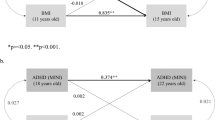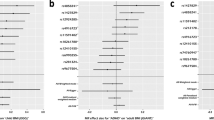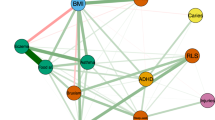Abstract
Objective:
There have been numerous reports on association between attention-deficit/hyperactivity disorder (ADHD) and overweight/obesity in children and adolescents; however, most studies adjusted only for a limited number of possible confounders.
Methods:
We analyzed the data of 11 159 six through seventeen-year-old participants in the German Health Interview and Examination Survey for Children and Adolescents. We determined weight status based on measured anthropometry and national reference data by International Obesity Task Force criteria. The parent-rated hyperactivity/inattention subscale of the Strengths and Difficulties Questionnaire (SDQ-HI) was used as a continuous measure of ADHD symptoms. We examined whether the putative confounders socioeconomic status, migrant status, parental body mass index (BMI) and parental smoking were associated with both SDQ-HI and overweight/obesity. Associations between SDQ-HI and overweight/obesity vs normal weight were analyzed by binary logistic regression analyses. In the first model, we adjusted for age and sex only and in the second model also for the parental confounders.
Results:
SDQ-HI was associated with an increased risk for overweight/obesity in both sexes adjusting for age and sex. However, after adjusting for all confounders SDQ-HI was associated with an increased risk for overweight/obesity only in adolescent females. Socioeconomic status, parental BMI and parental smoking each were relevant confounders. Migrant status was also significantly associated with both SDQ-HI and overweight/obesity, thus qualifying as a confounder but contributed only weakly to the association.
Conclusions:
The association between ADHD symptoms and overweight/obesity is due to confounding by family background variables in all but adolescent girls. Possible reasons for the increased risk for overweight/obesity in this subgroup are discussed. We also propose possible mechanisms for confounding by parental socioeconomic status, BMI and smoking.
This is a preview of subscription content, access via your institution
Access options
Subscribe to this journal
Receive 12 print issues and online access
$259.00 per year
only $21.58 per issue
Buy this article
- Purchase on Springer Link
- Instant access to full article PDF
Prices may be subject to local taxes which are calculated during checkout
Similar content being viewed by others
References
Wang Y, Lobstein T . Worldwide trends in childhood overweight and obesity. Int J Pediatr Obes 2006; 1: 11–25.
Kurth BM, Schaffrath Rosario A . [The prevalence of overweight and obese children and adolescents living in Germany. Results of the German Health Interview and Examination Survey for Children and Adolescents (KiGGS)]. Bundesgesundheitsblatt Gesundheitsforschung Gesundheitsschutz 2007; 50: 736–743.
Bauchner H . ADHD: A new practice guideline from the American Academy of Pediatrics. Attention deficit hyperactive disorder. Arch Dis Child 2000; 83: 63.
Cortese S, Vincenzi B . Obesity and ADHD: clinical and neurobiological implications. Curr Top Behav Neurosci 2012; 9: 199–218.
Holtkamp K, Konrad K, Muller B, Heussen N, Herpertz S, Herpertz-Dahlmann B et al. Overweight and obesity in children with attention-deficit/hyperactivity disorder. Int J Obes Relat Metab Disord 2004; 28: 685–689.
Braet C, Claus L, Verbeken S, Van Vlierberghe L . Impulsivity in overweight children. Eur Child Adolesc Psychiatry 2007; 16: 473–483.
Hubel R, Jass J, Marcus A, Laessle RG . Overweight and basal metabolic rate in boys with attention-deficit/hyperactivity disorder. Eat Weight Disord 2006; 11: 139–146.
Agranat-Meged AN, Deitcher C, Goldzweig G, Leibenson L, Stein M, Galili-Weisstub E . Childhood obesity and attention deficit/hyperactivity disorder: a newly described comorbidity in obese hospitalized children. Int J Eat Disord 2005; 37: 357–359.
Curtin C, Bandini LG, Perrin EC, Tybor DJ, Must A . Prevalence of overweight in children and adolescents with attention deficit hyperactivity disorder and autism spectrum disorders: a chart review. BMC Pediatr 2005; 5: 48.
Ptacek R, Kuzelova H, Paclt I, Zukov I, Fischer S . Anthropometric changes in non-medicated ADHD boys. Neuro Endocrinol Lett 2009; 30: 377–381.
Nederkoorn C, Braet C, Van Eijs Y, Tanghe A, Jansen A . Why obese children cannot resist food: the role of impulsivity. Eat Behav 2006; 7: 315–322.
Waring ME, Lapane KL . Overweight in children and adolescents in relation to attention-deficit/hyperactivity disorder: results from a national sample. Pediatrics 2008; 122: e1–e6.
Lam LT, Yang L . Overweight/obesity and attention deficit and hyperactivity disorder tendency among adolescents in China. Int J Obes (Lond) 2007; 31: 584–590.
Erhart M, Herpertz-Dahlmann B, Wille N, Sawitzky-Rose B, Holling H, Ravens-Sieberer U . Examining the relationship between attention-deficit/hyperactivity disorder and overweight in children and adolescents. Eur Child Adolesc Psychiatry 2012; 21: 39–49.
Drukker M, Wojciechowski F, Feron FJ, Mengelers R, Van Os J . A community study of psychosocial functioning and weight in young children and adolescents. Int J Pediatr Obes 2009; 4: 91–97.
Rojo L, Ruiz E, Dominguez JA, Calaf M, Livianos L . Comorbidity between obesity and attention deficit/hyperactivity disorder: population study with 13-15-year-olds. Int J Eat Disord 2006; 39: 519–522.
Graziano PA, Calkins SD, Keane SP . Toddler self-regulation skills predict risk for pediatric obesity. Int J Obes (Lond) 2010; 34: 633–641.
Mustillo S, Worthman C, Erkanli A, Keeler G, Angold A, Costello EJ . Obesity and psychiatric disorder: developmental trajectories. Pediatrics 2003; 111: 851–859.
Biederman J, Spencer TJ, Monuteaux MC, Faraone SV . A naturalistic 10-year prospective study of height and weight in children with attention-deficit hyperactivity disorder grown up: sex and treatment effects. J Pediatr 2010; 157: 635–640, e631.
Levy F, Hay DA, McStephen M, Wood C, Waldman I . Attention-deficit hyperactivity disorder: a category or a continuum? Genetic analysis of a large-scale twin study. J Am Acad Child Adolesc Psychiatry 1997; 36: 737–744.
Chen W, Zhou K, Sham P, Franke B, Kuntsi J, Campbell D et al. DSM-IV combined type ADHD shows familial association with sibling trait scores: a sampling strategy for QTL linkage. Am J Med Genet B Neuropsychiatr Genet 2008; 147B: 1450–1460.
Kleiser C, Schaffrath Rosario A, Mensink GB, Prinz-Langenohl R, Kurth BM . Potential determinants of obesity among children and adolescents in Germany: results from the cross-sectional KiGGS Study. BMC Public Health 2009; 9: 46.
Kurth BM, Kamtsiuris P, Holling H, Schlaud M, Dolle R, Ellert U et al. The challenge of comprehensively mapping children's health in a nation-wide health survey: design of the German KiGGS-Study. BMC Public Health 2008; 8: 196.
Cole TJ, Bellizzi MC, Flegal KM, Dietz WH . Establishing a standard definition for child overweight and obesity worldwide: international survey. BMJ 2000; 320: 1240–1243.
Goodman R . Psychometric properties of the Strengths And Difficulties Questionnaire. J Am Acad Child Adolesc Psychiatry 2001; 40: 1337–1345.
Goodman R, Meltzer H, Bailey V . The strengths and difficulties questionnaire: a pilot study on the validity of the self-report version. Int Rev of Psychiatry 2003; 15: 173–177.
Goodman R, Scott S . Comparing the strengths and difficulties questionnaire and the child behavior checklist: is small beautiful? J Abnorm Child Psychol 1999; 27: 17–24.
Goodman R, Ford T, Simmons H, Gatward R, Meltzer H . Using the strengths and difficulties questionnaire (SDQ) to screen for child psychiatric disorders in a community sample. Br J Psychiatry 2000; 177: 534–539.
Winkler J, Stolzenberg H . Der Sozialschichtindex im Bundes-Gesundheitssurvey. Gesundheitswesen 1999; 6: 178–183.
Davis C . Attention-deficit/hyperactivity disorder: associations with overeating and obesity. Curr Psychiatry Rep 2010; 12: 389–395.
Neumark-Sztainer D, Wall M, Larson NI, Eisenberg ME, Loth K . Dieting and disordered eating behaviors from adolescence to young adulthood: findings from a 10-year longitudinal study. J Am Diet Assoc 2011; 111: 1004–1011.
Nederkoorn C, Jansen E, Mulkens S, Jansen A . Impulsivity predicts treatment outcome in obese children. Behav Res Ther 2006; 45: 1071–1075.
van Egmond-Fröhlich A, Claussnitzer G, Dammann D, Eckstein E, Bräuer W, de Zwaan M . Parent reported inattention and hyperactivity/impulsivity as predictor of long-term weight loss after inpatient treatment in obese adolescents. Int J Eat Disord (accepted for publication).
Pauli-Pott U, Albayrak O, Hebebrand J, Pott W . Does inhibitory control capacity in overweight and obese children and adolescents predict success in a weight-reduction program? Eur Child Adolesc Psychiatry 2010; 19: 135–141.
Dumith SC, Gigante DP, Domingues MR, Kohl HW . Physical activity change during adolescence: a systematic review and a pooled analysis. Int J Epidemiol 2011; 40: 685–698.
Lahey BB, Pelham WE, Loney J, Lee SS, Willcutt E . Instability of the DSM-IV Subtypes of ADHD from preschool through elementary school. Arch Gen Psychiatry 2005; 62: 896–902.
Yeomans MR, Leitch M, Mobini S . Impulsivity is associated with the disinhibition but not restraint factor from the Three Factor Eating Questionnaire. Appetite 2008; 50: 469–476.
Schmidt RE, Gay P, Ghisletta P, VDL M . Linking impulsivity to dysfunctional thought control and insomnia: a structural equation model. J Sleep Res 2010; 19: 3–11.
Soetens B, Braet C, Dejonckheere P, Roets A . 'When suppression backfires': the ironic effects of suppressing eating-related thoughts. J Health Psychol 2006; 11: 655–668.
Erskine JA, Georgiou GJ . Effects of thought suppression on eating behaviour in restrained and non-restrained eaters. Appetite 2010; 54: 499–503.
Haines J, Kleinman KP, Rifas-Shiman SL, Field AE, Austin SB . Examination of shared risk and protective factors for overweight and disordered eating among adolescents. Arch Pediatr Adolesc Med 2010; 164: 336–343.
Pagoto SL, Curtin C, Lemon SC, Bandini LG, Schneider KL, Bodenlos JS et al. Association between adult attention deficit/hyperactivity disorder and obesity in the US population. Obesity (Silver Spring) 2009; 17: 539–544.
de Zwaan M, Gruss B, Muller A, Philipsen A, Graap H, Martin A et al. Association between obesity and adult attention-deficit/hyperactivity disorder in a German community-based sample. Obes Facts 2011; 4: 204–211.
Schisterman EF, Cole SR, Platt RW . Overadjustment bias and unnecessary adjustment in epidemiologic studies. Epidemiology 2009; 20: 488–495.
MacKinnon DP, Krull JL, Lockwood CM . Equivalence of the mediation, confounding and suppression effect. Prev Sci 2000; 1: 173–181.
Goodman A, Goodman R . Strengths and difficulties questionnaire as a dimensional measure of child mental health. J Am Acad Child Adolesc Psychiatry 2009; 48: 400–403.
Becker A, Hagenberg N, Roessner V, Woerner W, Rothenberger A . Evaluation of the self-reported SDQ in a clinical setting: do self-reports tell us more than ratings by adult informants? Eur Child Adolesc Psychiatry 2004; 13 (Suppl 2) II17–II24.
Polderman TJ, Boomsma DI, Bartels M, Verhulst FC, Huizink AC . A systematic review of prospective studies on attention problems and academic achievement. Acta Psychiatr Scand 2010; 122: 271–284.
de Graaf R, Kessler RC, Fayyad J, ten Have M, Alonso J, Angermeyer M et al. The prevalence and effects of adult attention-deficit/hyperactivity disorder (ADHD) on the performance of workers: results from the WHO World Mental Health Survey Initiative. Occup Environ Med 2008; 65: 835–842.
Fayyad J, De Graaf R, Kessler R, Alonso J, Angermeyer M, Demyttenaere K et al. Cross-national prevalence and correlates of adult attention-deficit hyperactivity disorder. Br J Psychiatry 2007; 190: 402–409.
Faraone SV, Perlis RH, Doyle AE, Smoller JW, Goralnick JJ, Holmgren MA et al. Molecular genetics of attention-deficit/hyperactivity disorder. Biol Psychiatry 2005; 57: 1313–1323.
Barkley GS . Factors influencing health behaviors in the National Health and Nutritional Examination Survey, III (NHANES III). Soc Work Health Care 2008; 46: 57–79.
Cutler GJ, Flood A, Hannan P, Neumark-Sztainer D . Multiple sociodemographic and socioenvironmental characteristics are correlated with major patterns of dietary intake in adolescents. J Am Diet Assoc 2011; 111: 230–240.
Wagner A, Klein-Platat C, Arveiler D, Haan MC, Schlienger JL, Simon C . Parent-child physical activity relationships in 12-year old French students do not depend on family socioeconomic status. Diabetes Metab 2004; 30: 359–366.
Gubbels JS, Kremers SP, Stafleu A, de Vries SI, Goldbohm RA, Dagnelie PC et al. Association between parenting practices and children's dietary intake, activity behavior and development of body mass index: the KOALA Birth Cohort Study. Int J Behav Nutr Phys Act 2011; 8: 18.
Cortese S, Angriman M, Maffeis C, Isnard P, Konofal E, Lecendreux M et al. Attention-deficit/hyperactivity disorder (ADHD) and obesity: a systematic review of the literature. Crit Rev Food Sci Nutr 2008; 48: 524–537.
Silventoinen K, Rokholm B, Kaprio J, Sorensen TI . The genetic and environmental influences on childhood obesity: a systematic review of twin and adoption studies. Int J Obes (Lond) 2010; 34: 29–40.
Kollins SH, McClernon FJ, Fuemmeler BF . Association between smoking and attention-deficit/hyperactivity disorder symptoms in a population-based sample of young adults. Arch Gen Psychiatry 2005; 62: 1142–1147.
Fuemmeler BF, Kollins SH, McClernon FJ . Attention deficit hyperactivity disorder symptoms predict nicotine dependence and progression to regular smoking from adolescence to young adulthood. J Pediatr Psychol 2007; 32: 1203–1213.
McClernon FJ, Kollins SH . ADHD and smoking: from genes to brain to behavior. Ann NY Acad Sci 2008; 1141: 131–147.
Dallongeville J, Marecaux N, Fruchart JC, Amouyel P . Cigarette smoking is associated with unhealthy patterns of nutrient intake: a meta-analysis. J Nutr 1998; 128: 1450–1457.
Yore MM, Fulton JE, Nelson DE, Kohl HW . Cigarette smoking status and the association between media use and overweight and obesity. Am J Epidemiol 2007; 166: 795–802.
Klesges RC, Ward KD, Ray JW, Cutter G, Jacobs DR, Wagenknecht LE . The prospective relationships between smoking and weight in a young, biracial cohort: the Coronary Artery Risk Development in Young Adults Study. J Consult Clin Psychol 1998; 66: 987–993.
Acknowledgements
The KiGGS study was funded by the German Federal Ministry of Health, the Ministry of Education and Research and the Robert Koch Institute. We thank the Robert Koch Institute for the provision of the KiGGS public use file.
Author information
Authors and Affiliations
Corresponding author
Ethics declarations
Competing interests
The authors declare no conflict of interest.
Rights and permissions
About this article
Cite this article
van Egmond-Fröhlich, A., Widhalm, K. & de Zwaan, M. Association of symptoms of attention-deficit/hyperactivity disorder with childhood overweight adjusted for confounding parental variables. Int J Obes 36, 963–968 (2012). https://doi.org/10.1038/ijo.2012.78
Received:
Revised:
Accepted:
Published:
Issue Date:
DOI: https://doi.org/10.1038/ijo.2012.78
Keywords
This article is cited by
-
ADHD in childhood predicts BMI and body composition measurements over time in a population-based birth cohort
International Journal of Obesity (2022)
-
The association between obesity and hyperactivity/anxiety among elementary school students in Japan
International Journal of Behavioral Medicine (2020)
-
Overweight in family members of probands with ADHD
European Child & Adolescent Psychiatry (2019)
-
Normal diet Vs High fat diet - A comparative study: Behavioral and neuroimmunological changes in adolescent male mice.
Metabolic Brain Disease (2018)
-
Attention-Deficit/Hyperactivity Disorder (ADHD) and Obesity: Update 2016
Current Psychiatry Reports (2017)



